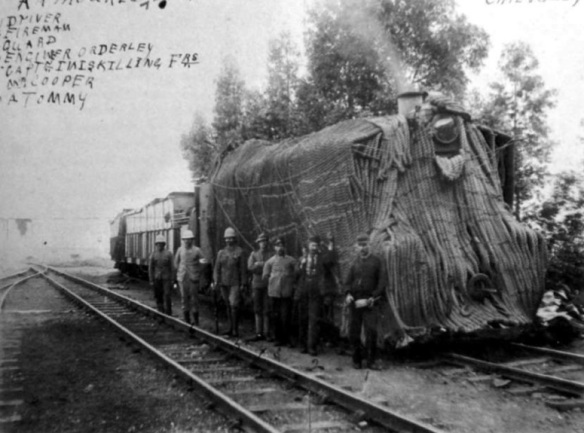Hairy Mary, the engine of the armoured train reinforced with rope-work protection. This marvel was created with 2,000 fathoms of 6in. rope by men of HMS Terrible at Chieveley.
15 November 1899
The British dependency on the railways for the movement of supplies led them to convert railway wagons into mobile mini-forts. Their extreme limitations of manoeuvre – either forwards, backwards or standstill – made them vulnerable to well-planned attacks unless they had supporting troops. On 15 November 1899 a train was sent by Colonel C. J. Long from Frere northwards to Colenso. It was halted at Chieveley where the Boers had destroyed the line and then started back but it was ambushed by the Boers and partially derailed at the crossing of the Blaawkrantz River. The young Winston Churchill was a passenger and he helped get part of the train moving once more but was himself captured. He was imprisoned in the prisoner-of-war camp in Pretoria from which he managed to escape to Lourenço Marques in Portuguese East Africa. He made his way back to Durban where he received a hero’s welcome which did much for his political career.
This particular train was scarcely armoured, but was armed. There was an open ordinary wagon in front (when going north) with a 7-pounder muzzle-loading gun crewed by men of HMS Tartar, an open wagon modified with some armour and with loopholes in front of the engine, and two armoured wagons behind which a regular wagon was attached with line repair equipment. Under Captain J. A. L. Haldane 120 men of the Dublin Fusiliers and Durban Light Infantry manned the train. The photographs of the wreck suggest that no explosive shells were used and shells found recently have their fuses set at safety. It appears that in their haste and excitement, the Boer gunners forgot to arm their shells. Later in the war locomotives were protected with elaborate ropework jackets and railway wagons were modified to provide stronger protection for armed men. Trains were also converted to hospital carriages for the transportation of the wounded.
